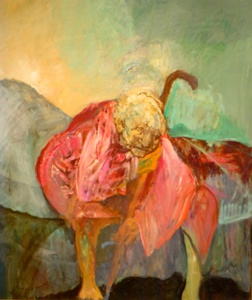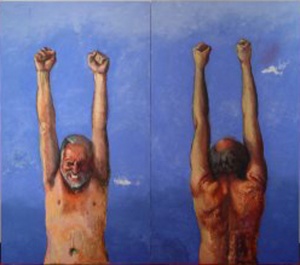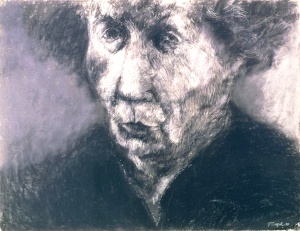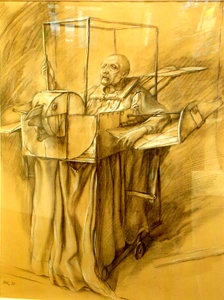The Art of Aging
Hyman Bloom’s haunting painting Old Woman in Red presents us with a central paradigm of aging: its universality. Our past and inevitable future are frequently seen in depictions of the very old. In image after image the exhibition The Art of Aging mercilessly presents the undeniable connection between a communal past and our future. The old are living witnesses to the past, to lives lived remarkably like ours. Conversely, the hunched back, wrinkled face and slowed gait is a sure forecast of our future. While many of us will grow old with depressingly similar symptoms this exhibition expansively affirms that old age is considerably more than the portal to death, rather it is seen as expressing every aspect of a vital and creative life.

The Art of Aging, curated by Laura Kruger, presents one hundred and forty-one works of painting, sculpture, photography, installation and mixed media by eighty-three artists from Israel and America. This impressive and diverse survey of the myriad aspects of aging includes many major artists including Samuel Bak, Hyman Bloom, Audrey Flack, Ben Katchor, Schwebel, George Segal, Kiki Smith, Joan Snyder, and Art Spiegelman among many others.
Bloom’s painting, painted over a period of sixty-six years and finished this year, shows a seated old woman resting on her cane in a luminous Goyaesque landscape. She has traversed a very long way and yet her firm grasp of the cane implies she will soon rise up and stride further still. Her red garment, a lively incongruous color for such an old lady, reminds us of her youth and vigor. Bloom’s woman may look ancient but her spirit and determination shine through in every brushstroke.

Among the many ideas explored is the confrontation with old age. Sigmund Abeles’ Who Can Forget How Blue the Sky Was Beforehand (2001) presents the struggle of the artist himself, growing gray. He rails at the sky, stretching with clenched fists in protest against the inevitable diminution of physical ability. The simultaneous front and back views extend his protest into the depth of the painting and project it out to the audience like two towers of defiance. A similar confrontation seen from an entirely different perspective, is George Segal’s Helen V (1996).

This large (38 X 50) pastel on paper is a penetrating portrait of his wife done only a few years before both he and his wife passed away. Her gaze rivets us in accusation while her pursed lips seem to demand that we provide a satisfactory accounting of our lives. The cropped image engages the viewer unlike any other in the show.
Some of the images elegantly depict the old, as in the masterful series of four black and white photographs by Aliza Auerbach of elderly kibbutz workers; useful and still creative after many years of hard toil. The connections with the land of Israel and its productivity reminds us of the effort required to maintain a country. Other artists take a more philosophical approach reflecting the entire process of life, cradle to grave. Audrey Flack’s sculpture of her one hundred-year-old mother, The Hand That Rocks the Cradle is the Hand That Rolls the Dice (2003) plays with irony and visual puns. She crowns her mom’s wrinkled face with a set of five dice that evoke the element of chance and our scant control over life’s vicissitudes. Carol Hamoy’s Six Months (2002) presents a mixed media landscape of one person’s life. A fractured photograph of a baby boy on a bearskin rug is contrasted with nine pages of his diary kept in the last six months of his life. The long years between are inevitably evoked as we ponder the beginning and end.
Biblical themes address old age in distinctly unfamiliar formats. Joyce Ellen Weinstein explores the death of Moses in Behold Thy Days Approach (2003). It is a mixed media unique book that ponders the complex relationship between God and His faithful servant, Moses, prohibited from fulfilling his overwhelming desire to enter the Land of Israel. Combining biblical texts, midrashim, references to Honi the Circle Drawer and poetry the work protests the seeming injustice even as it accepts the notion that when God decrees, even the hour of our death, we must obediently comply. Natan Nuchi’s Binding of Isaac (1984) is seen in an even more radical light as a nocturnal meditation on the unnatural death of a son before his father. Isaac is cradled in the arms of Abraham as they stare imploringly into each other’s eyes, trying to understand the incomprehensible decree of sacrifice. It is said the mourning for one’s child is never ending.
The exhibition does not shy away from confrontation with the termination of old age in death. Box (1993) by Norma Minkowitz is an unsettling representation of the very concept of death. The form of a head, actually a crocheted mask, rests in a small rectangular box that is lined with dried autumn leaves. The outside of the box is laminated with newspaper obituaries, creating a macabre faux funerary monument that deftly combines the symbolism of fallen leaves with a very real text and the impression of a shell-like mask left behind by the departed. In an equally evocative manner Jane Logemann’s pencil drawing Kaddish (1995) uses the Hebrew alphabet primitively lettered to slowly and hesitantly spell out the Mourner’s Kaddish, first in the center surrounding an English translation and then in Aramaic over and over again to the bottom of the page. This subtle work summons the first uncomfortable experience of saying Kaddish for a loved one. The words, like the writing in the drawing, come with difficulty, and only slowly comfort as they praise God and look forward to His reign even in our time of sorrow.

Samuel Bak’s Old Man’s Departure flows effortlessly from Psalm 90; “The days of our years among them are seventy years, and if with strength, eighty years; their proudest success is but toil and pain, for it is cut off swiftly and we fly away.” Bak pictures an old man seated in a bizarre contraption. It is wooden mechanical bird with levers and flaps for wings and a comical beaked head that expects to take flight at any moment. The drawing is dedicated to “the restless spirit of my stepfather, a survivor of Dachau…” who was tortured by memories and nightmares until the final last journey brought him “his first deep and peaceful sleep in over twenty-five years.” Aging is the journey that brings us all to a final departure. The Art of Aging shows us in our past and in our futures many of the ways to get there.